|
|
|
Sort Order |
|
|
|
Items / Page
|
|
|
|
|
|
|
| Srl | Item |
| 1 |
ID:
171499


|
|
|
|
|
| Summary/Abstract |
This research centers around the question: How can provincial governments take the lead in implementing an adaptive governance approach considering citizen-led wind energy development? A framework for ‘accommodative leadership’ was created - building on the work of Meijerink and Stiller (2013) regarding leadership in climate change adaptation, and the work of Sotarauta (2010) on place leadership. The combination of the two provides a leadership framework which aims to include both governmental actors and local citizens initiatives as potential leaders in wind energy development.
Three cases studies in three regions of the Netherlands were assessed. The results show that provinces adopt various leadership styles, referred to as ‘facilitative decentralization’, ‘deliberative innovation’ and ‘authoritative reluctance’. Our conclusion is that there is no roadmap for effective accommodative leadership, as it occurs in many forms. Nonetheless the developed framework can be used by regional governments as an assessment tool to understand the roles and actions which can potentially be taken by this authority to purposefully allocate their leadership capacities, while allowing citizen-led wind energy development.
|
|
|
|
|
|
|
|
|
|
|
|
|
|
|
|
| 2 |
ID:
171518


|
|
|
|
|
| Summary/Abstract |
California law requires statewide greenhouse gas (GHG) emissions to return to 1990 levels by 2020—a goal achieved in 2016, four years early. We conduct the first independent retrospective analysis of California's greenhouse gas emissions to assess how the state has achieved faster-than-expected emissions reductions. We analyze the extent to which economic activity, climate policies, and market forces drove California's greenhouse gas emissions trends overall and in two key categories: electricity and light-duty vehicles. We also compare historical trends with business-as-usual and policy expectations from the 2008 Climate Change Scoping Plan, California's official strategy for achieving the 2020 emissions limit. Our analysis, based on data through 2017, indicates that reduced economic activity during the 2008–2009 recession and its aftermath has been a major contributor to early achievement of the 2020 emissions limit. Policies and market forces, however, have played a larger role in reducing emissions in recent years—particularly in the electricity sector, which has decarbonized more rapidly than expected. Meanwhile, GHG emissions from light-duty vehicles in recent years were rising, not falling, in contrast to expectations. Our analysis demonstrates how decomposition methods can be used to track climate policy implementation and inform future policy development.
|
|
|
|
|
|
|
|
|
|
|
|
|
|
|
|
| 3 |
ID:
171493


|
|
|
|
|
| Summary/Abstract |
Based on a survey among customers of seven German municipal utilities, we estimate two regression models to identify the most prospective customer segments and their preferences and motivations for participating in peer-to-peer (P2P) electricity trading and develop implications for decision-makers in the energy sector and policy-makers for this currently relatively unknown product. Our results show a large general openness of private households towards P2P electricity trading, which is also the main predictor of respondents' intention to participate. It is mainly influenced by individuals’ environmental attitude, technical interest, and independence aspiration. Respondents with the highest willingness to participate in P2P electricity trading are mainly motivated by the ability to share electricity, and to a lesser extent by economic reasons. They also have stronger preferences for innovative pricing schemes (service bundles, time-of-use tariffs). Differences between individuals can be observed depending on their current ownership (prosumers) or installation probability of a microgeneration unit (consumers, planners). Rather than current prosumers, especially planners willing to install microgeneration in the foreseeable future are considered to be the most promising target group for P2P electricity trading. Finally, our results indicate that P2P electricity trading could be a promising niche option in the German energy transition.
|
|
|
|
|
|
|
|
|
|
|
|
|
|
|
|
| 4 |
ID:
171511
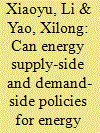

|
|
|
|
|
| Summary/Abstract |
Existing literature mainly focuses on the combined effect of different policies on energy, economy and environment. However, most of them were based on the perspective of energy demand-side. In order to fill this gap, we study the effect of carbon tax and coal capacity cut from both the energy demand-side and energy supply-side using a dynamic Computable General Equilibrium (CGE) model. Different policy effects including single one and synergistic one are compared. Moreover, the synergy degrees of coal capacity cut and carbon tax in energy saving, emission reduction and economic growth are evaluated. The results show that both coal capacity cut and carbon tax are beneficial to energy conservation and carbon emission mitigation at the expense of a slight loss in economy. Mixed policy has better performance than single policy in carbon emission reduction and energy saving. Also, a more stringent policy is conducive to carbon emission mitigation and energy conservation. Additionally, there are significant synergistic effect of coal capacity cut and carbon tax from the perspectives of energy saving, emission reduction and economic growth. Therefore, the mixed policy of coal capacity cut and carbon tax should be promoted and an appropriate stringency level of policy mix should be adopted.
|
|
|
|
|
|
|
|
|
|
|
|
|
|
|
|
| 5 |
ID:
171508


|
|
|
|
|
| Summary/Abstract |
We investigate the question of whether spending to enable ambitious EV roll-out programmes can in fact generate net gains across the wider economy. We use a multi-sector computable general equilibrium (CGE) model for the UK economy and focus on the need to upgrade electricity networks to support an initial EV penetration scenario for the period to 2030. We find that large scale spending and cost recovery for network upgrades is likely to result in net negative impacts on key macroeconomic indicators, including real income available for spending across all UK households. This is due to a combination of time-limited network upgrade activity in the presence of capacity constraints combined with the need for costs to be passed on to electricity consumers through higher bills. But the lowest income households – the group of greatest concern to policymakers – suffer the smallest losses. Moreover, the EV uptake delivers sufficient gains that deliver net positive impacts on all household incomes, with sustained expansion in GDP and employment across the economy. The key driver is a greater reliance on UK supply chains with the shift away from more import-intensive petrol and diesel fuelled vehicles towards electric ones.
|
|
|
|
|
|
|
|
|
|
|
|
|
|
|
|
| 6 |
ID:
171522


|
|
|
|
|
| Summary/Abstract |
This paper investigates the effect of two different community solar remuneration models on the overall willingness to buy of Swiss electricity customers (n = 496). Based on practical observation, the two main remuneration models that dominate today's implementation landscape for community solar were identified. The first of the former delivers solar power directly from community solar plants, while the second delivers financial compensation instead of solar power. A between-subject-design experiment applying pro-environmental behavior as approximation for intrinsic motivation demonstrated that remuneration schemes which avoid mentioning financial benefits and instead compensate customers with the solar power are particularly attractive to green electricity customers who have higher intrinsic motivation to consume pro-environmental electricity. Offering financial benefits may even discourage these customers from participating in community solar. On the other hand, offering financial benefits appeals to default electricity customers whose intrinsic motivation for pro-environmental behavior is too weak to trigger a reaction to the ecological and local benefits of community solar alone. When designing policies around community solar or implementing community solar projects, policy makers and practitioners should thus carefully analyze the customer base and its composition in order to match remuneration schemes to customer preferences.
|
|
|
|
|
|
|
|
|
|
|
|
|
|
|
|
| 7 |
ID:
171514


|
|
|
|
|
| Summary/Abstract |
In order to explore the decoupling relationship and its influence factors between the growth of China's civil aviation sector and carbon emissions, as well as to forecast future CO2 emissions, the extended log-mean Divisia index model (LMDI), Tapio decoupling model and an emission prediction model were applied in this study. The results show the following. (1) Total carbon emissions fluctuate on an overall upward trend, but the level of oil consumption per revenue tonne-kilometers (RTK) shows a steady downward trend. (2) Among the four main factors, the “transportation amount growth” factor contributed most to CO2 emissions increases; followed by transport structure adjustment effects and alternative fuel effects. The “energy consumption intensity” factor plays a major role in inhibiting CO2 emissions. (3) The decoupling state of civil aviation predominantly stayed in a weak decoupling prior to 1988, expansive coupling and expansive negative decoupling during 1988–2000, and expansive coupling post-2000, which implies that the government should take comprehensive measures to reduce CO2 emissions. (4) Based on eight scenarios, China's civil aviation sector is predicted to be responsible for 0.13 Gt of CO2 emissions by 2020. Between 2020 and 2050, CO2 emissions may increase by a factor 1.6 to 3.9.
|
|
|
|
|
|
|
|
|
|
|
|
|
|
|
|
| 8 |
ID:
171480


|
|
|
|
|
| Summary/Abstract |
This paper considers bubbles specific to Chinese renewable energy industries, including wind, solar and hydro through the Generalized Supremum Augmented Dickey-Fuller test. It applies the recursive procedure and cross-time occurrence to identify starting and ending points in each bubble. Combining with the bubble model, the empirical results reveal that renewable energy industrial stock price may deviate from their market value, and bubble behaviours exist in these industries. The potential reasons can be contributed to economic growth, trade barrier, government supportive policies, global financial crisis, and environmental protection pressure. More attention is further paid on special factors such as extreme windy weather, unfair anti-dumping investigation and less policy support which can explain certain bubbles in wind, solar and hydro industries. The renewable energy industries' boom and recession that evidence from bubble behaviour, would harm industrial development, influence thousands of people's lives, and bring challenges for Chinese energy structure and policies. Therefore, depending on the timely identification of explosive behaviours and bubbles, policymakers could set up prudent policy framework, reduce government intervention and render firms autonomy to maintain the sustained and healthy development of industries. More importantly, enterprises should increase research and development expenditure, upgrade technical standard and exploit international renewable energy market.
|
|
|
|
|
|
|
|
|
|
|
|
|
|
|
|
| 9 |
ID:
171520
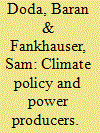

|
|
|
|
|
| Summary/Abstract |
Climate policies do not affect all power producers equally. In this paper, we evaluate the supply-side distributional consequences of emissions reduction policies using a simple and novel partial equilibrium model where production takes place in technology-specific sites. In a quantitative application hydro, wind and solar firms generate power combining capital and sites which differ in productivity. In contrast, the productivity levels of coal, gas and nuclear technologies are constant across sites. We parameterise the model to analyse the effects of stylised tax and subsidy schemes. Carbon pricing outperforms all other instruments and, crucially, leads to more equitable outcomes on the supply side. Technology-specific and uniform subsidies to carbon-free producers result in a greater welfare cost and their supply-side distributional impacts depend on how they are financed. Power consumption taxes have exceptionally high welfare costs and should not be the instrument of choice to reduce emissions or to finance subsidies aiming to reduce emissions.
|
|
|
|
|
|
|
|
|
|
|
|
|
|
|
|
| 10 |
ID:
171510


|
|
|
|
|
| Summary/Abstract |
Individuals' use of smart energy technology – i.e., technology that increases energy efficiency or increases the integration of renewable energy sources – holds great potential to solve the energy-related climate problem. However, individuals' current uptake of smart energy technology is low. If policymakers are to successfully address this issue, it is vital that they understand the determinants of individuals' smart energy technology adoption. Hence, this paper provides a comprehensive adoption model for smart energy technology, including data from over 4k individuals in Europe, Asia, and North America involved in various technological contexts and phases of diffusion. A meta-analysis identifies Attitude and Performance Expectancy as the primary determinants of individuals’ smart energy technology adoption. Further, results show that Environmental Concern influences all other determinants. Implications for research and policymakers are discussed.
|
|
|
|
|
|
|
|
|
|
|
|
|
|
|
|
| 11 |
ID:
171471


|
|
|
|
|
| Summary/Abstract |
The PBE program made the adoption of energy labels mandatory in the Brazilian refrigerator market. In this paper, we examine the effects of PBE using data from a nationally representative sample of households and a structural model of appliance choice. We document a modest increase in the valuation of energy costs by Brazilian consumers. However, the program is unable to eliminate the energy efficiency gap, in that consumers undervalue energy costs both pre-and post-PBE. Moreover, our policy simulation documents little product switching and heterogeneity in responses. All in all, while the PBE program aimed to both reduce energy consumption and increase energy efficiency, we can only claim robust evidence of the latter.
|
|
|
|
|
|
|
|
|
|
|
|
|
|
|
|
| 12 |
ID:
171521
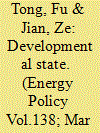

|
|
|
|
|
| Summary/Abstract |
Fossil fuel has been the main raw material in electricity generation though it is also the source of greenhouse gases and anthropogenic emissions from air pollution. To minimize the consumption of fossil fuel out of environmental concern, electricity needs to be allocated efficiently. Mainstream economics advocates arm’s-length regulation in allocation of utility products, but regulatory systems in most developing countries are underdeveloped. To the best of our knowledge, this paper offers the first attempt to identify that the trajectory of a developmental state is an option to a developing country. With micro-evidence from China, we document that more reliable electricity is supplied to firms with high value added, with robustness to the potential endogeneity bias. Thus, we find that electricity-allocation efficiency in China is positive and causally meaningful. As we further show, three important conditions of a developmental state determine allocative efficiency: political stability promotes allocative efficiency; whereas both corruption and harmful tax policies reduce allocative efficiency. Ultimately, we show that electricity in a developing country can be allocated efficiently by a developmental state even though its utility regulations are not mature.
|
|
|
|
|
|
|
|
|
|
|
|
|
|
|
|
| 13 |
ID:
171524


|
|
|
|
|
| Summary/Abstract |
A widespread implicit assumption is that renewable energy options are approximately low-carbon. However, production and life cycles of such technologies tend to produce CO2 emissions. To minimize life-cycle emissions, one should account for such emissions and implement adequate policies to encourage innovation and adoption of well-performing technologies in this respect. We develop a framework to analyse this issue, grounded in the concepts of ‘energy return on energy invested’ (EROI) and ‘net energy return on carbon invested’ (EROC). Applying these to the main PV technologies and production regions – namely China, EU and USA – displays considerable discrepancies. We conditionally predict the development of average EROI and EROC over time under business-as-usual and low-carbon electricity generation scenarios. A main policy lesson is that without a systemic policy instrument, such as carbon pricing, incentives for low-carbon production of renewable energy options are too weak, which likely will delay a complete transition to a low-carbon economy.
|
|
|
|
|
|
|
|
|
|
|
|
|
|
|
|
| 14 |
ID:
171503


|
|
|
|
|
| Summary/Abstract |
To address increasing opposition to wind projects in Denmark three compensation schemes were introduced in the 2008 Renewable Energy Act. The aim was to address issues of distributive fairness and thereby to increase local acceptance. This paper analyses the role of two individual compensation schemes – the property value-loss scheme and the co-ownership scheme – on local citizens’ perceptions of fair distribution of the benefits and burdens of wind energy projects. The qualitative case study of three Danish wind energy projects discloses that distributive unfairness was a prevalent concern among local citizens, and that this concern was inseparable from perceptions of procedural fairness and recognition. The key conclusion is that the two compensation schemes are not successfully offsetting perceptions of unfair distribution. The schemes are challenged by a multitude of intertwined concerns. The compensation schemes are not equipped to address the plethora of non-monetary values affected by the wind projects. Specifically the compensation schemes are criticised for not offering adequate local benefits or distribution thereof, equal access, fair procedures and transparency. In fact the schemes were by some considered unfair and created perceptions of lack of recognition and bribery which undermined their role in promoting distributive fairness and local acceptance.
|
|
|
|
|
|
|
|
|
|
|
|
|
|
|
|
| 15 |
ID:
171484
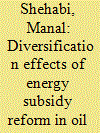

|
|
|
|
|
| Summary/Abstract |
For oil exporters, energy subsidy reform and economic diversification are critical policy responses to recent fundamental changes in the global oil market and oil price declines, yet the relationship between them is little understood. This article investigates linkages between energy subsidy reform and accelerating economic diversification away from hydrocarbons in a low oil price environment, using illustrations from Kuwait. It employs an economy-wide, general equilibrium model with oligopolistic industrial structure, the first of its kind for an economy in the Middle East and North Africa, that embodies unique elements of the country's economic structure—oil dependence; public sector dominance; subsidies; sovereign wealth funds; industrial collusive pricing behaviour; and guest workers. The article argues that, contrary to common popular discourse, Kuwait's economy has a diversified economic base, but this base fails to diversify export or government revenue needed for economic sustainability. Results show that weak economic diversification in oil exporters with a similar economic structure is not primarily due to “Dutch disease,” as dominant in the literature, but to economic constraints and distortions that impair structural change and exacerbate overdependence on hydrocarbons. Labour and competition reforms relax some constraints, achieving large efficiency gains that extend economy-wide and can expand non-energy tradable sectors. The analysis has important policy implications. First, the potential role of pricing regulation in small economies in moderating economic impacts of negative oil shocks. Second, in oil economies characterized by pervasive oligopolies, microeconomic reform can be a channel to achieve efficiency and better diversification effects of subsidy reform.
|
|
|
|
|
|
|
|
|
|
|
|
|
|
|
|
| 16 |
ID:
171512


|
|
|
|
|
| Summary/Abstract |
Firms around the world need to find ways to continuously reduce their carbon footprint, preferably in ways that are profitable or cost-effective. The opportunities available to them will change over time, as they implement the most profitable ones first and as technology changes. When designing and adjusting their carbon policies, policy-makers need to understand the abatement opportunities firms are facing. We explore this using data collected by CDP (formerly the Carbon Disclosure Project) on 20,920 carbon abatement projects implemented by more than 1400 firms worldwide over 7 years. Using fixed effects regression with energy price controls by country, our results show that the average payback period of implemented carbon emissions reduction projects remained relatively constant from 2010-2016, although there is tentative evidence that the projects are becoming smaller over time. We provide a novel firm-level perspective on carbon emissions reduction activities using data on projects implemented and reported by large, global firms, and discuss how the insights from such firm-level analysis can help inform the design and revision of carbon emissions policies over time.
|
|
|
|
|
|
|
|
|
|
|
|
|
|
|
|
| 17 |
ID:
171519
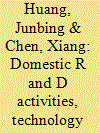

|
|
|
|
|
| Summary/Abstract |
Domestic research and development (R&D) activities are critical for the development of China's low-carbon economy. The higher level of R&D inputs, the more advanced technology will generate, therefore contributing to the energy intensity reduction. In empirical studies, the effect of R&D activities on energy intensity has been investigated extensively, however, most studies consider R&D activities as a whole. Consequently, we lack detailed information on the role of each R&D player and stage for appropriate policy consideration. Furthermore, the effects of R&D activities may be determined by factors affecting technology absorptive ability. To understand the influence of R&D activities on energy intensity, we employ linear and nonlinear analyses using a Chinese provincial dataset covering 2000–2016. The linear analysis suggests that domestic R&D is powerful in reducing energy intensity. However, this positive effect is mainly from experimental and developmental R&D activities rather than basic R&D and application activities. Further, R&D activities by industrial enterprises have a stronger effect on energy intensity reduction than those of higher education and independent R&D institutions. Additional study using panel threshold models suggests that the effects are not linear but experience structural breaks when human capital stock and full-time equivalent (FEP) R&D personnel are at different levels.
|
|
|
|
|
|
|
|
|
|
|
|
|
|
|
|
| 18 |
ID:
171486


|
|
|
|
|
| Summary/Abstract |
In Europe, space and water heating account for approximately 80% of final energy use in the domestic sector. For many European countries the electrification of heat provision, via heat pumps (HPs), provides a promising decarbonisation pathway. The UK is no different, but recently concerns have been raised about the financial attractiveness of HPs given how, through various policy choices, taxes and levies are applied more heavily on electricity bills than gas bills. In this paper, we critically examine this argument by assessing the financial attractiveness of HPs across their lifetime for a typical UK household and within the current UK tax and regulatory regime. The results suggest taxes and levies do weaken the economic case for HPs: their current distribution having an unintended impact on the economics of HPs. Nonetheless, they are not the only reason for HPs comparative financial disadvantage. Upfront costs and HP performance, both influence the extent to which taxes and levies impact the economics of HPs. The results have implications for the future deployment of HPs in the UK and point towards policies to increase deployment (to drive down costs) and increase HP performance as being important.
|
|
|
|
|
|
|
|
|
|
|
|
|
|
|
|
| 19 |
ID:
171517


|
|
|
|
|
| Summary/Abstract |
One important and frequently-raised issue about foreign direct investment (FDI) is the potentially negative consequences for the environment. The potential environmental cost due to increased emissions may undermine the economic gains associated with increases in FDI inflow. Although the literature is dominated with this adverse view of FDI on the environment, there is also a possibility that FDI can contribute to a cleaner environment, especially, if FDI comes with green technologies and this creates spillovers for domestic industries. Theoretically, the effect of FDI on the environment can be negative or positive. To deal with the theoretical ambiguity about the FDI-environment nexus, many empirical studies have been conducted but their results only reinforce the controversy as they produce contrasting results. We conduct a meta-analysis of the effect of FDI on environmental emissions using 65 primary studies that produce 1006 elasticities. Our results show that the underlying effect of FDI on environmental emissions is close to zero, however, after accounting for heterogeneity in the studies, we find that FDI significantly reduces environmental emissions. Results remain robust after disaggregating the effect for countries at different levels of development as well as for different pollutants.
|
|
|
|
|
|
|
|
|
|
|
|
|
|
|
|
| 20 |
ID:
171478


|
|
|
|
|
| Summary/Abstract |
Renewable energy electricity, such as photovoltaic (PV) power generation, has the benefits of strengthening energy security, addressing climate change, reducing air pollution, etc., but there are some impediments to deployment of renewable energy electricity: higher costs than fossil fuels, intermittent energy production, site constraints, etc. Korea changed its renewable energy electricity support systems from feed-in tariff (FIT) to a renewable portfolio standard (RPS) in 2012. This study evaluates FIT versus RPS in terms of the time to reach grid parity for PVs. Using a learning curve model, we calculate the learning rate of PV power generation during the FIT and RPS periods. We find that the PV learning rate during the RPS period was 18.44%, much higher than that during the FIT period, −0.28%, and R2 is 0.9861 and 0.7346 in the RPS and FIT periods, respectively. Using the calculated learning rate in the RPS period, we also predict that grid parity for PVs is expected in 2025 in Korea.
|
|
|
|
|
|
|
|
|
|
|
|
|
|
|
|
|
|
|
|
|